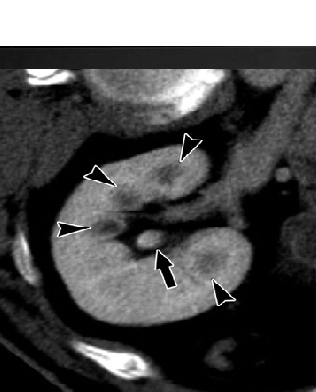Diabetes patient with AKI, right flank pain and gross hematuria.
medcases00
Published on Feb 5, 2022
45-year-old man with a history of diabetes mellitus for more than 10 years presents to the emergency room with worsening right flank pain and gross amounts of blood in his urine. He also has mild dysuria and has no previous episode of hematuria . He has no family history of cancer and no smoking history. Physical exam shows tenderness to palpation in the right flank . urinalysis reveals hematuria, 2 plus proteinuria without any WBC. His A1c is 14.5 range and his hgb is 15.1 range and Creatinine increased from baseline of 1.3 range to 2.4 on presentation. No recent weight loss.
Which of the following is the most likely diagnosis?
A. Papillary necrosis
B. Medullary sponge kidney
C. Pyelonephritis
D. Renal infarction
E. Renal Cancer
Answer is A.
Contrast-enhanced parenchymal phase CT image shows multiple poorly marginated, hypoattenuated lesions (arrowheads) in the papillary regions and the excretion of contrast material into the renal pelvis (arrow). •Lesion is described as a ring shadow in the calyx with complete necrosis and loss of entire papillary surface leads to “claw-like†papillary area appearance. Differential diagnosis of conditions in which papillary necrosis is noticed includes sickle cell disease, pyelonephritis, diabetes, and renal tuberculosis, ADPKD.
Sickle cell disease is suspected based on history. complete occlusion of the vasa recta can lead to renal papillary necrosis with sloughing of the ischemic papilla, severe hemorrhage, and obstruction, leading to UTI and painful clot colic Renal Tuberculosis manifests as unilateral disease, sterile pyuria, small capacity bladder and calcifications in seminal vesicles, or prostate. urine cultures need to sent for AFB. ADPKD can present with papillary necrosis, but has cysts in renal parenchyma. Medullary sponge kidney is associated with medullary calcification, but not with the irregular kidney contour of papilla that is typical of papillary necrosis. renal infraction presents as wedge shaped peripheral lesion.
Renal Cancer less likely based on CT scan appearance, non smoking history, age group, lack of weight loss. Renal Malignancy has been associated with sickle cell trait or HbSC- Renal medullary carcinoma is an aggressive form of renal cell carcinoma that uniquely affects young patients with sickle cell hemoglobinopathies . Chronic medullary hypoxia is main contributing factor contributing to increased sickling. The tumors are typically located deep in the parenchymahave poor survival rates with resistant to chemotherapy and tend to be metastatic at time of diagnosis. Gross hematuria, flank pain, and weight loss are ominous signs of malignancy in patients with sickle cell trait.
Reference
1. Radiological changes of renal papillary necrosis- https://pubmed.ncbi.nlm.nih.gov/713272/
2. Lobster claw sign: Renal papillary necrosis- https://pubmed.ncbi.nlm.nih.gov/30309154/











